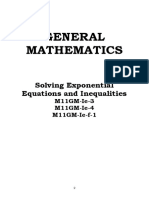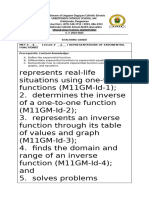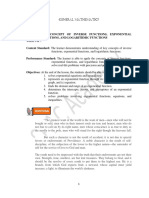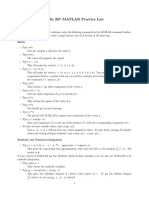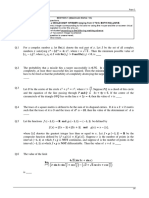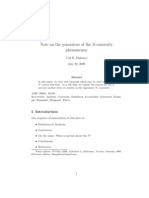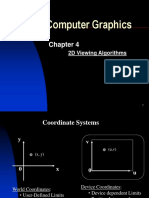Concept and Solving Exponential Function: Equations - PDF Objectives
Uploaded by
ChristianConcept and Solving Exponential Function: Equations - PDF Objectives
Uploaded by
ChristianConcept and Solving Exponential Function:
Reference: http://www.wallace.ccfaculty.org/book/10.4%20Exponential
%20Equations.pdf
Objectives
It will explain what is the concept of exponential function
It will explain how to solve a exponential function
if b is any number such that b> 0 and b ≠ 1 then an Exponential function is a
function form.
f (x) = Bx
where b is called the base and x can be any real number.
Notice that the x is now in the exponent and the base is a fixed number. This is
exactly the opposite from what we’ve to this point. To this point base has been
the variable, x in most cases, and the exponent was a fixed number. However,
despite these differences these function evaluate in exactly the same way as
those that we are used to. We will see some examples of exponential function
shortly.
Before we get too far into this section we should address the restrictions on b.
we avoid one and zero because in this case the function would be,
f (x) = 0x = 0 and f (x) = 1x = 1
and these are constant function and won’t have many of the same properties
that general exponential function have.
Next, we avoid the negative numbers so that we don’t get any complex values
out of the function evaluation. For instance, if we allowed b = -4 function would
be.
f (x) = (-4)x ⇒ f(12)=(−4)12=√-4
and as you can see there are some function evaluations that will give complex
numbers. We only want real numbers to arise from function evaluation and so
to make sure of this we require that b not be a negative number.
Mark Angelo Sanchez Stem11y1-2
If we have several factors with the same base on one side of the equation we
can add the exponent using the property that states axay=ax+y.
54r52r-1= 53r+11 Add the Exponents on the left combining like terms
56r-1=53r+11 Same base, set exponents equal
6r-1= 3r + 11 Move variables to one sides
-3r -3r Subtract 3r from both sides
3r-1 = 11 Add 1 to the both side
+1 +1
3r = 12 Divide both side by 3
3 3
r=4 Our solution
KEY CONCEPT IN EXPONENTIAL FUNCTION
An exponential function is defined function with a positive constant other
than 1 raised to a variable exponent.
A function is evaluated by solving at a specific input value.
An exponential model can be found when the growth rate and initial
value are known.
An exponential model can be found when two data points from the model
is unknown.
An exponential model can be found using two data points from the graph
of the model.
The value of an account at any time t can be calculated using the
compound interest formula when the principal, annual interest rate, and
compounding periods are known.
The initial investment of an account can be found using the compound
interest formula when the value of the account annual interest rate,
compounding periods and life span of the account are known.
The number e is a mathematical constant often used as the base of real
world exponential growth and decay models. Its decimal approximation is
e≈ 2.718282.
Scientific and graphing calculators have the key [e2] or [exp (x)] for
calculating powers of e.
Continuous growth or decay models are exponential models that uses e
as the base. Continuous growth and decay rate are known.
Mark Angelo Sanchez Stem11y1-2
EXERCISE
Solve the following exponential function
Given the function f(x) = 4x evaluate the following
1. f(-2)
2. f(-½)
3. f(3/2)
4. f(-3)
5. f(-1)
ASSIGNMENT
Given the function f(x) =9x evaluate each of the following. 2 POINTS EACH
1. f(−3)
2. f(−1)
3. f(0)
4. f(1/2)
5. f(3/2)
6. f(5)
7. f(3)
8. f(12)
9. f(10
10. f(9)
Mark Angelo Sanchez Stem11y1-2
You might also like
- This Study Resource Was: 11.1 User-Defined Functions: Miles To Track LapsNo ratings yetThis Study Resource Was: 11.1 User-Defined Functions: Miles To Track Laps9 pages
- IB Mathematics Analysis and Approaches MappingNo ratings yetIB Mathematics Analysis and Approaches Mapping40 pages
- Exponential Functions: General Mathematics Lesson 4No ratings yetExponential Functions: General Mathematics Lesson 423 pages
- Quarter-12-Week-5_Gen-Math-Lesson-16-18-2024No ratings yetQuarter-12-Week-5_Gen-Math-Lesson-16-18-202430 pages
- Section 6-1: Exponential Functions: B B FX BNo ratings yetSection 6-1: Exponential Functions: B B FX B6 pages
- Learning Concepts and Activities: Page - 1No ratings yetLearning Concepts and Activities: Page - 16 pages
- Graphing Exponential Functions and Solving Exponential Equations and InequalitiesNo ratings yetGraphing Exponential Functions and Solving Exponential Equations and Inequalities2 pages
- Exponential Functions: More Mathematical ModelingNo ratings yetExponential Functions: More Mathematical Modeling38 pages
- Real-Life of Exponential Functions and Their Transformations Are, Population GrowthNo ratings yetReal-Life of Exponential Functions and Their Transformations Are, Population Growth3 pages
- GRADE 11 Learning Module 2 Semester Finals: General MathematicsNo ratings yetGRADE 11 Learning Module 2 Semester Finals: General Mathematics10 pages
- GenMath LAS q1 w6 Exponential-Function v1No ratings yetGenMath LAS q1 w6 Exponential-Function v14 pages
- Thomas ' Calculus: Early Transcendentals: FunctionsNo ratings yetThomas ' Calculus: Early Transcendentals: Functions13 pages
- Solving Exponential Equations:: Ex 1: SolveNo ratings yetSolving Exponential Equations:: Ex 1: Solve8 pages
- Exponential and Logarithmic Functions 4No ratings yetExponential and Logarithmic Functions 423 pages
- Ficha de Trabalho Exponencial e Logaritmica Vida Real ProblemasNo ratings yetFicha de Trabalho Exponencial e Logaritmica Vida Real Problemas46 pages
- STEM-exponential-functions-and-equations-answer-keyNo ratings yetSTEM-exponential-functions-and-equations-answer-key6 pages
- 4.1-Exponential-Equations-and-InequalitiesNo ratings yet4.1-Exponential-Equations-and-Inequalities5 pages
- Lecture 3 Exponential and Logarithmic FunctionsNo ratings yetLecture 3 Exponential and Logarithmic Functions58 pages
- Weekly Assignments Semester 1 Math 30-2 2019-2020No ratings yetWeekly Assignments Semester 1 Math 30-2 2019-20206 pages
- Computer Graphics: 2D Viewing AlgorithmsNo ratings yetComputer Graphics: 2D Viewing Algorithms22 pages
- How To Start Programming in Python - 15 Steps - WikiHowNo ratings yetHow To Start Programming in Python - 15 Steps - WikiHow8 pages
- Chapter 1. Multivariable Calculus: Vietnam National University-Ho Chi Minh City International UniversityNo ratings yetChapter 1. Multivariable Calculus: Vietnam National University-Ho Chi Minh City International University88 pages
- Internalize, Don't Memorize.: UPCAT Math CoverageNo ratings yetInternalize, Don't Memorize.: UPCAT Math Coverage2 pages
- LKM Kalin - Thoiffatul Khusnun Nisa'-023 PDF100% (1)LKM Kalin - Thoiffatul Khusnun Nisa'-023 PDF8 pages


















